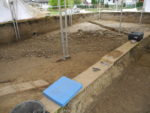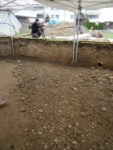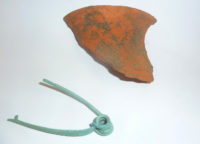 An archaeological survey at the site of a housing development in Egolzwil, Switzerland, has discovered rare remains of a Celtic settlement. Canton archaeologists excavating the site about 20 miles northwest of Lucerne unearthed evidence of a Celtic-era street and dwelling, the first traces of an actual Celtic settlement discovered in the canton. Before this discovery, the only material evidence of Celts having lived in the area were sacrificial remains found at what used to be the Wauwilersee lakeshore.
An archaeological survey at the site of a housing development in Egolzwil, Switzerland, has discovered rare remains of a Celtic settlement. Canton archaeologists excavating the site about 20 miles northwest of Lucerne unearthed evidence of a Celtic-era street and dwelling, the first traces of an actual Celtic settlement discovered in the canton. Before this discovery, the only material evidence of Celts having lived in the area were sacrificial remains found at what used to be the Wauwilersee lakeshore.
Wauwilersee, a glacier lake that was drained in the mid-19th century to reclaim the boggy land for agricultural purposes, was the site of one of the earliest human settlements in Switzerland. Remains have been found going back to the late Paleolithic (ca. 12,000 B.C.) and Neolithic pile dwelling settlements have been declared UNESCO World Heritage Sites. It’s this rich density of material culture dating back thousands of years that spurred the survey before construction of three semi-detaches houses on the Egolzwil-Baumgarten rail line.
 The settlement remains were found on a hill overlooking the former Wauwilersee shore. The dig found a pathway about 13 feet wide made of small, compacted pebbles and the remains of a house that had burned down. It’s not known whether the path was a road linking locations within the settlement or if it was a stretch of a larger road that connected Egolzwil to the nearby town of Schötz. Most of the archaeological material unearthed consists of potsherds, small stones from the pathway, larger round stones used in construction of the dwelling and scorched fragments of the house’s clay walls. One stand-out artifact is a bronze fibula, a large pin used to secure garments together. It is of a type commonly dating to the 1st century B.C.
The settlement remains were found on a hill overlooking the former Wauwilersee shore. The dig found a pathway about 13 feet wide made of small, compacted pebbles and the remains of a house that had burned down. It’s not known whether the path was a road linking locations within the settlement or if it was a stretch of a larger road that connected Egolzwil to the nearby town of Schötz. Most of the archaeological material unearthed consists of potsherds, small stones from the pathway, larger round stones used in construction of the dwelling and scorched fragments of the house’s clay walls. One stand-out artifact is a bronze fibula, a large pin used to secure garments together. It is of a type commonly dating to the 1st century B.C.
Very little is known about the Celtic period (ca. 800-15 B.C.) in the canton of Lucerne which is why this dig, so small in surface area, is so large in historical significance. That the house was burned down in the 1st century B.C. is particularly intriguing because of the potential connection to the events recorded by Julius Caesar in the opening of Gallic War. It all starts with Orgetorix, the richest and most powerful leader of the Helvetii (the varied, loose confederation of Celtic peoples in the Swiss Plateau) who in 61 B.C. persuades other leaders to head for larger and greener pastures by invading Gaul. Orgetorix never did his dream of war come true because his compatriots turned on him, afraid he would make himself king. He died (possibly by suicide) while on trial. That didn’t stop them from going through with the whole Gaul plan, though. In 58 B.C., they lit the match on the tinderbox that became the Gallic War.
When they thought that they were at length prepared for this undertaking, they set fire to all their towns, in number about twelve-to their villages about four hundred-and to the private dwellings that remained; they burn up all the corn, except what they intend to carry with them; that after destroying the hope of a return home, they might be the more ready for undergoing all dangers. They order every one to carry forth from home for himself provisions for three months, ready ground. They persuade the Rauraci, and the Tulingi, and the Latobrigi, their neighbors, to adopt the same plan, and after burning down their towns and villages, to set out with them: and they admit to their party and unite to themselves as confederates the Boii, who had dwelt on the other side of the Rhine, and had crossed over into the Norican territory, and assaulted Noreia.
 Noricum, believed to be in modern-day Austria, was a long-time Roman ally, provider of a great deal of the army’s weapons and tools. In return, Roman forces had defended it against Germanic incursions since the early 2nd century B.C. The Helvetian invasion triggered Caesar’s response, and the rest, as they say, is history.
Noricum, believed to be in modern-day Austria, was a long-time Roman ally, provider of a great deal of the army’s weapons and tools. In return, Roman forces had defended it against Germanic incursions since the early 2nd century B.C. The Helvetian invasion triggered Caesar’s response, and the rest, as they say, is history.
So, there is a general possibility that the Celtic house was burned down when the Helvetii arsoned themselves out of a homeland to ensure there would be no going back, but there’s no evidence of this fire having been part of the exodus. It could simply have been an accidental house fire like any other. More investigation will have to be done.
The excavation will only continue through the end of the month. With no time and no money to extend the dig, the site will be infilled for now for its own protection. Archaeologists plan to return when they have the wherewithal to excavate the site further.
Of course, Caesar needed a pretext to “liberate” what he made up as Gaul (trans Alpina) :skull: